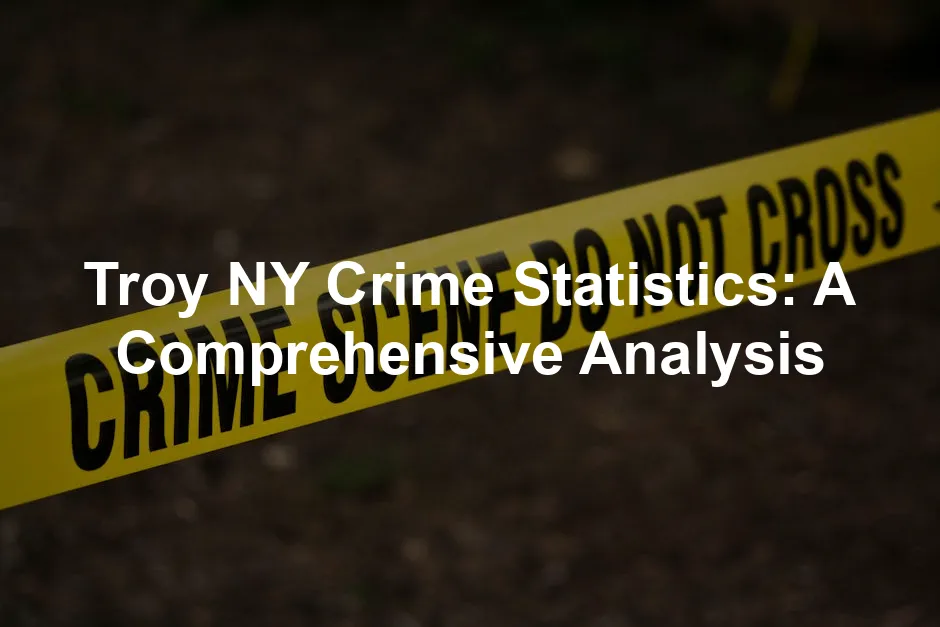Introduction
Understanding crime statistics in Troy, NY, is crucial for residents, potential movers, and policymakers. Knowing the local crime rates can empower individuals to make informed decisions about their safety and community. For those contemplating a move, these statistics can reveal whether Troy is the right fit for their lifestyle. Policymakers can use this data to identify areas needing attention and resources.
This article draws on various credible sources, including NeighborhoodScout and Niche, to provide an in-depth look at crime in Troy. We aim to break down the statistics into digestible insights, exploring trends, comparisons with state and national averages, and community perceptions.
Speaking of safety, if you want to keep your home secure, consider investing in a Home Security Camera System. It’s a great way to keep an eye on things while you’re away, and you’ll feel like a security expert in no time!
Throughout our exploration, we’ll highlight the current crime rates, delve into historical context, and discuss how these figures shape the community’s views on safety. Whether you’re a lifelong resident or just curious about Troy’s safety, this analysis will equip you with valuable information about crime in this unique city.

Overview of Troy’s Crime Rates
Current Crime Rates
Troy, NY, has an overall crime rate of 41 incidents per 1,000 residents, which might raise eyebrows. To put it into perspective, residents face a 1 in 24 chance of becoming a crime victim, which is notably higher than the national average. Comparatively, more than 98% of communities in New York report lower crime rates than Troy.
When considering the specifics, Troy’s violent crime rate stands at 6.86 per 1,000 residents, which is significantly higher than both the state average of 4.29 and the national median of 4. This includes key offenses such as murder, rape, robbery, and assault, which we’ll analyze in detail later.
Property crimes also paint a concerning picture. The property crime rate in Troy is 34.50 per 1,000 residents, far exceeding the New York state average of 17.22 and the national average of 20. Residents should be aware of these statistics when assessing neighborhood safety.
To enhance your personal safety, consider having a Personal Safety Alarm handy. It’s like having a superhero in your pocket, ready to alert everyone if you find yourself in a pinch!
In summary, Troy’s crime rates are critical for understanding the city’s safety landscape. They highlight not only the challenges the community faces but also the importance of informed discussions about crime prevention and public safety initiatives.

Historical Context
Troy, NY, has experienced notable fluctuations in crime rates over the past decade. Analyzing crime data reveals a rollercoaster of trends. In 2012, the violent crime rate stood at 664.8 incidents per 100,000 residents. Fast forward to 2015, and it peaked at a staggering 858.2. However, by 2018, it had decreased to a more manageable 571.8. The numbers tell a compelling story.
From 2020 to 2022, crime statistics continued to shape the narrative. In 2020, the violent crime rate was 600.6, which saw a slight decline to 582.4 in 2021. By 2022, it had dropped further to 369.2. This downward trend in violent crime is a welcome change for Troy residents.
Here’s a snapshot of the statistics from these years:
| Year | Violent Crime Rate (per 100k) | Total Violent Crimes |
|---|---|---|
| 2020 | 600.6 | 337 |
| 2021 | 582.4 | 312 |
| 2022 | 369.2 | 182 |
These numbers illustrate a positive shift, indicating concerted efforts towards improving safety in the community. Visual aids like graphs can help further demystify these trends, making them easier to digest.

Violent Crime Statistics
Breakdown of Violent Crimes
Violent crimes encompass serious offenses that threaten bodily harm. These include murder, rape, robbery, and assault. Understanding these categories is crucial for grasping the safety dynamics within Troy.
- Murder: 5 incidents (0.10 per 1,000 residents)
- Rape: 27 incidents (0.53 per 1,000 residents)
- Robbery: 83 incidents (1.63 per 1,000 residents)
- Assault: 234 incidents (4.60 per 1,000 residents)
Troy’s overall violent crime rate stands at 6.86 per 1,000 residents. In comparison, the state average is 4.29, while the national average is 4. This emphasizes the unique challenges Troy faces.
Analyzing recent trends reveals some intriguing insights. The murder rate, while concerning, has shown a decrease from the peak years. For instance, in 2020, the murder rate reached 10, but by 2022 it dropped to 5. Rape incidents have fluctuated but remain a critical concern, with a notable 27 reported in 2022.
Robberies and assaults have been the most prevalent violent crimes in Troy. Robberies peaked at 83, while assaults numbered 234. Notably, the number of assaults indicates a potential area for targeted community safety initiatives.
To ensure personal safety, consider carrying a Pepper Spray. It’s a compact tool that can provide peace of mind when you’re out and about, just in case you need to give an unwelcome visitor a wake-up call!
In conclusion, while Troy’s violent crime statistics present a mixed bag, the downward trend in certain areas is promising. This ongoing analysis helps residents stay informed about their community’s safety landscape and encourages proactive measures for improvement.

Comparison with New York State and National Averages
Troy’s violent crime rate stands at a staggering 6.86 per 1,000 residents. To compare, New York State averages a more moderate 4.29 per 1,000, while the national average is 4 per 1,000. So, what’s going on in Troy? It’s not just a statistical anomaly; several factors contribute to these elevated rates.
One significant element is socioeconomic status. Areas with higher poverty rates often experience increased crime. In Troy, around 23.1% of the population lives below the poverty line, which is significantly above the national average of 15.1%. When people struggle to meet basic needs, crime rates can spike as individuals resort to illegal activities for survival.
Additionally, Troy’s population density plays a role. With 4,755 people per square mile, higher density can lead to competition for limited resources, resulting in increased tensions and crimes. The city’s historical economic shifts also have left some neighborhoods struggling, further exacerbating these issues.

In light of these statistics, investing in a Smart Doorbell Camera can provide a sense of security. You’ll know who’s at your door without even getting up from the couch—talk about a game-changer!
Understanding this context is crucial. It helps residents, potential movers, and policymakers grasp the complexities behind the statistics. Recognizing these factors can foster discussions around community support and crime prevention strategies, ultimately aiming to improve Troy’s safety landscape.

Property Crime Statistics
Breakdown of Property Crimes
Property crimes include various offenses that involve the theft of property. These crimes are a significant concern for residents. The primary categories of property crime are burglary, theft, and motor vehicle theft.
- Burglary: This involves entering a building unlawfully with the intent to commit theft or another crime. In Troy, there were 256 burglaries reported, translating to a rate of 5.03 per 1,000 residents.
- Theft: This is the most common property crime, encompassing a wide array of offenses, from shoplifting to pickpocketing. Troy reported an alarming 1,383 thefts, leading to a rate of 27.17 per 1,000 residents.
- Motor Vehicle Theft: This category includes the theft of cars, trucks, and motorcycles. In Troy, there were 117 motor vehicle thefts, equating to a rate of 2.30 per 1,000 residents.
The overall property crime rate in Troy is 34.50 per 1,000 residents, significantly exceeding both the New York state average of 17.22 and the national average of 20. This discrepancy raises important questions about community safety and the effectiveness of law enforcement.
Analyzing trends in property crime over recent years reveals a mixed picture. While some types of property crime have fluctuated, overall numbers have remained consistently high. For instance, in 2020, property crime rates surged, prompting community concern. However, there have been efforts to address these issues through increased police presence and community programs.

To keep your valuables secure, consider investing in a Home Safe. It’s a great way to keep your important documents and valuables out of reach from prying eyes!
Moreover, understanding the dynamics of property crime is crucial for residents. By recognizing patterns and areas most affected, individuals can take proactive measures to protect themselves and their property. Engaging in neighborhood watch programs, enhancing home security, and fostering community ties can significantly reduce the risk of becoming a victim.
In conclusion, the current landscape of property crime in Troy highlights a pressing need for comprehensive strategies to tackle these issues. By fostering cooperation between law enforcement and the community, there is potential for meaningful change. As Troy continues to evolve, staying informed about property crime trends can empower residents and enhance overall safety.

Comparison with New York State and National Averages
Troy’s property crime rate is a staggering 34.50 per 1,000 residents. To put that in perspective, New York State averages just 17.22 per 1,000 residents. The national average is slightly higher at 20 per 1,000 residents. So, what’s the deal with Troy?
Several factors may lead to these elevated crime rates. First, socioeconomic conditions play a significant role. With around 23.1% of Troy’s population living below the poverty line, it’s clear that many residents face economic hardships. Unfortunately, when basic needs aren’t met, some individuals may resort to crime.
Additionally, Troy’s population density is another factor. With approximately 4,755 residents per square mile, this high density can create competition for resources. Such competition can lead to increased tensions in certain areas, contributing to the crime rates we see today.

To combat these issues, you might want to consider installing Motion Sensor Outdoor Lights. They can deter potential thieves by lighting up any movement in your yard, making you feel like a security pro!
Another element to consider is the city’s historical context. Troy has seen economic shifts over the years, leaving some neighborhoods struggling. Areas that once thrived may now face challenges, resulting in higher crime rates. Addressing these root causes is essential for any effective crime reduction strategy.

Neighborhood Insights
Popular Neighborhoods in Troy
Troy boasts several neighborhoods, each with its own character and safety levels. Notable areas include Clums Corner, Sycaway, and South Troy.
Clums Corner, known for its vibrant community, has a mix of families and young professionals. Crime rates here tend to be lower, making it attractive for those looking for a safe environment. Residents often speak highly of their neighborhood, with one local noting, “I feel comfortable walking my dog at night. It’s a friendly area.”
Sycaway, on the other hand, presents a different picture. While it features beautiful parks and schools, crime rates are higher than the Troy average. Some residents express concern, with one saying, “You have to be aware of your surroundings, especially at night.”
South Troy has its charm, but it also faces challenges. The neighborhood has seen fluctuations in crime, particularly property crime. A recent survey indicated that while some residents enjoy their community, others feel uneasy. One resident mentioned, “There are good people here, but crime is a concern.”
Survey data further highlights perceived safety across neighborhoods. Approximately 45% of Troy residents feel “pretty safe,” while 27% report feeling “somewhat safe.” These insights reveal a community grappling with its safety perceptions, influenced by crime statistics.

In light of the importance of safety, consider wearing an LED Safety Vest when you’re out walking or biking at night. It’s a simple way to ensure you’re seen and stay safe!
In conclusion, understanding the varying crime rates across these neighborhoods is crucial for residents and potential movers. Each area in Troy presents its own unique blend of safety and community spirit. By sharing these insights, we empower individuals to make informed decisions about where to live in this historic city.

Nearby Communities
Troy, NY, isn’t an island of crime—it’s surrounded by several lively communities, each with its unique vibe and crime statistics. Just a short drive away, Albany, the state capital, reports a notably higher overall crime rate of 56 per 1,000 residents. Residents in Albany have a 1 in 18 chance of becoming a victim. Meanwhile, Cohoes, a charming city nearby, boasts a lower crime rate, with only 28 incidents per 1,000 residents.
When comparing these statistics, Troy’s overall crime rate of 41 per 1,000 residents sits somewhere in the middle. While Troy’s property crime rate is higher than Cohoes, it remains lower than Albany’s violent crime rate. In essence, Troy’s crime situation feels like a neighborhood watch meeting: there’s concern, but it varies from block to block.

Community Perspectives on Crime
Safety Poll Results
Surveys conducted among Troy residents paint a picture of mixed feelings about safety. About 45% of respondents reported feeling “pretty safe” in their neighborhoods. This suggests a general sense of community, despite the lurking shadow of crime statistics. However, 27% of residents expressed feeling “somewhat safe,” indicating they have their guard up.
Law enforcement visibility plays a crucial role here. A sizeable 45% of residents believe the police are “very visible and responsive.” But, there’s still a portion who feel police presence is lacking. A mere 5% said law enforcement isn’t around much and is unreliable. This inconsistency in perception hints at the ongoing challenge of ensuring safety in Troy.

Resident Experiences
Anecdotes from Troy residents offer a fascinating glimpse into the community’s psyche. One longtime resident shared, “I’ve lived here for over a decade. Sure, there are incidents, but I’ve never felt unsafe walking my dog in the evening.” This sentiment is echoed by others who emphasize the importance of neighborhood camaraderie and vigilance.
Conversely, another resident noted, “You can hear stories about crime, but most of it is blown out of proportion.” This highlights a common theme: perceptions of crime often diverge from reality. While statistics might suggest a high risk, personal experiences can tell a different story.
In fact, a recent survey revealed that while 45% of residents feel safe, 14% believe crime is virtually non-existent in their neighborhoods. This variance showcases the complexity of community safety perceptions.

Conclusion
Troy’s crime statistics present a mixed landscape. With an overall crime rate of 41 per 1,000 residents, it’s crucial for residents and potential movers to stay informed. Comparatively, nearby communities demonstrate varying levels of safety, influencing how residents perceive their own neighborhoods.
Understanding these statistics empowers individuals to make informed decisions. It’s essential to engage in community discussions, advocate for better law enforcement practices, and explore potential safety initiatives. As Troy continues to evolve, active participation from residents can lead to improved safety and a more vibrant community. After all, informed citizens are the best line of defense against crime.
And if you’re looking to add some fun to your life, why not check out a Portable Bluetooth Speaker? It’s perfect for those backyard BBQs or just jamming out while you do chores!
Please let us know what you think about our content by leaving a comment down below!
Thank you for reading till here 🙂
All images from Pexels




